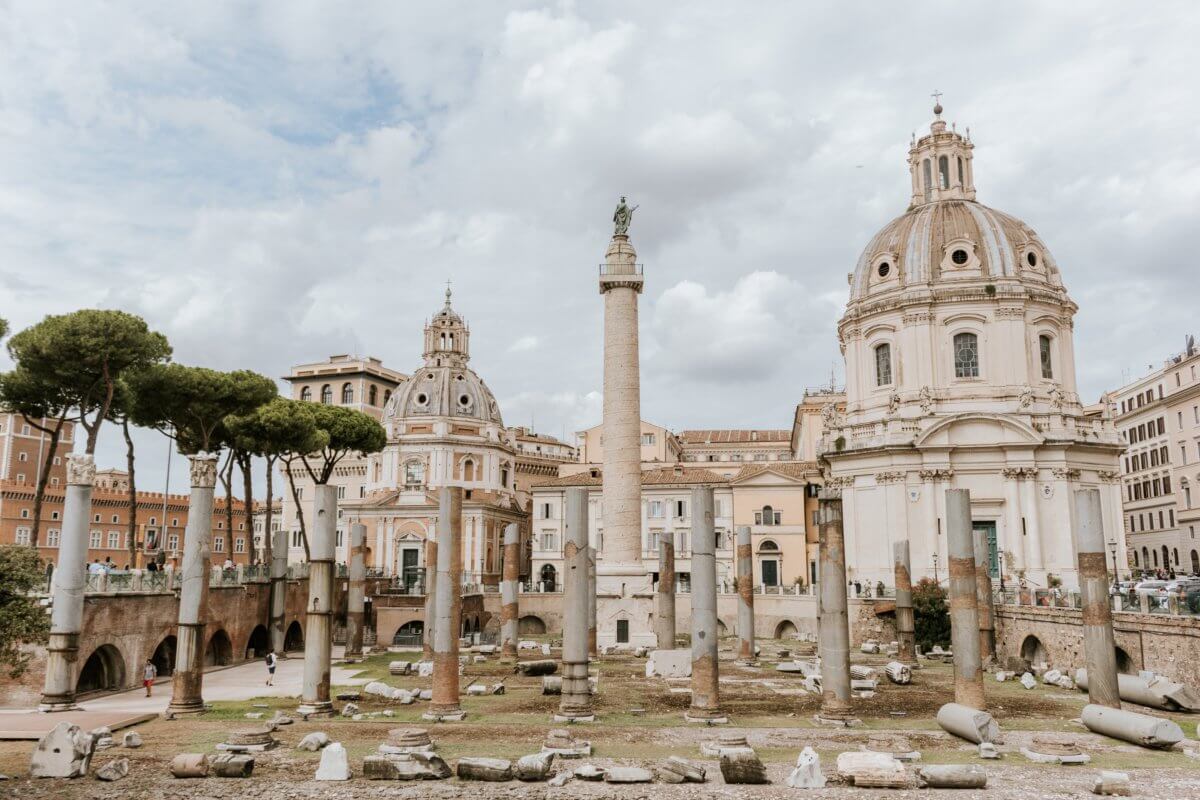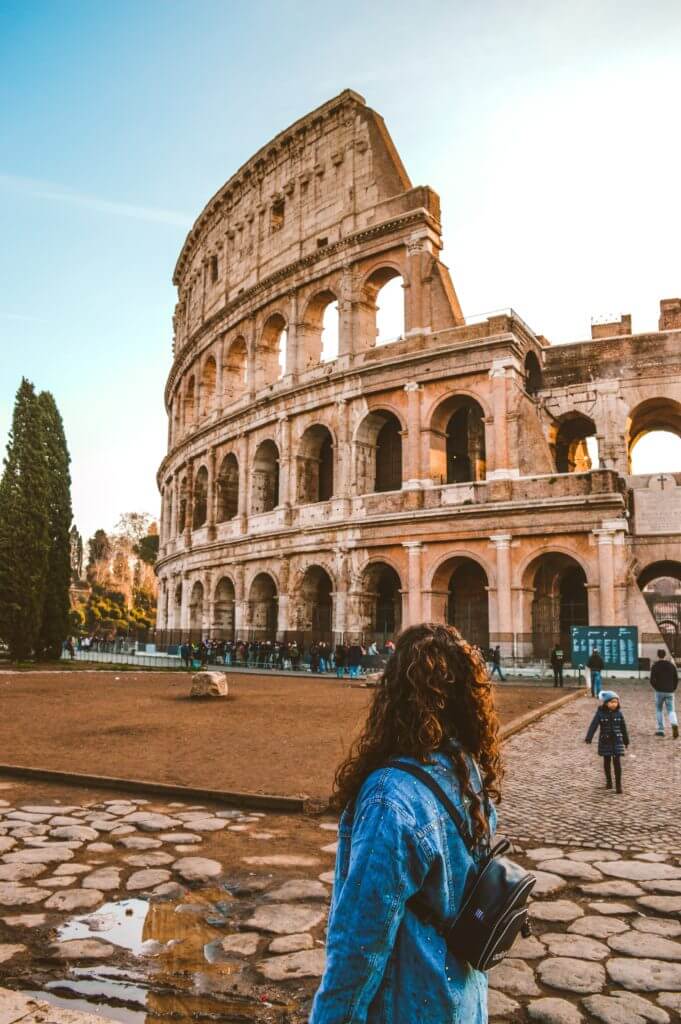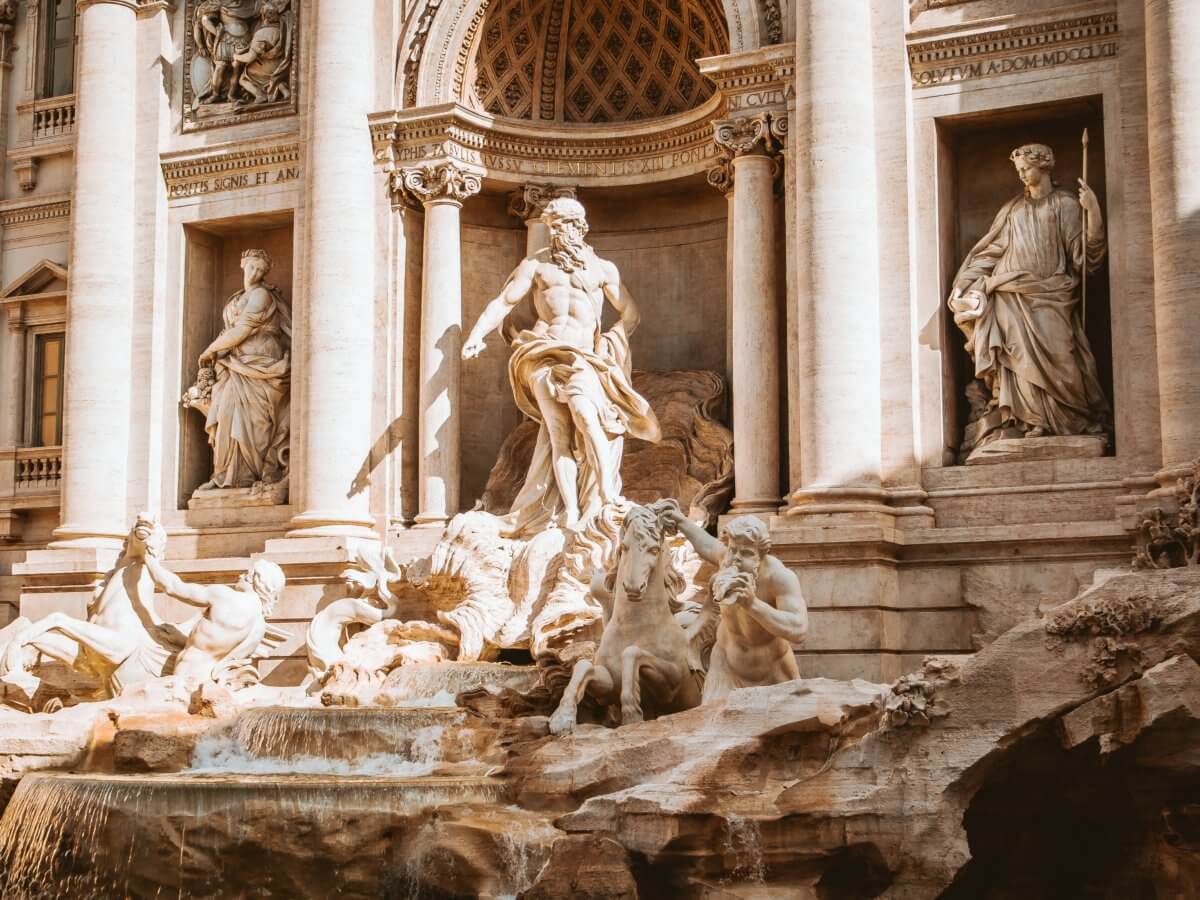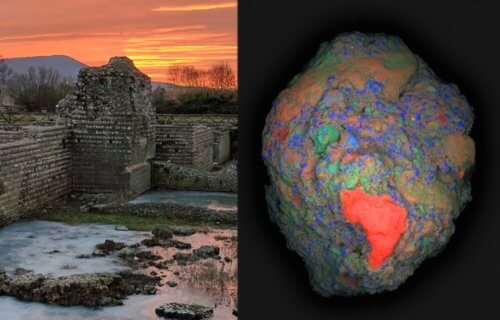CAMBRIDGE, Mass. — The secret to the durability of Roman concrete — which has stood the test of time for over 2,000 years — has finally been unearthed.
Scientists from MIT have isolated the ingredient that allows Roman concrete to “self-heal,” making it stronger than its modern equivalent. Their “back to the future” findings could help reduce the environmental impact of cement production in today’s society.
The ancient Romans were masters of engineering, building a huge network of roads, aqueducts, ports, and temples — many of which still stand to this very day! Many of these structures were built with concrete, including Rome’s Pantheon, which has the world’s largest unreinforced concrete dome and is still intact despite being dedicated in the year 128 AD. Some ancient Roman aqueducts still deliver water to the Eternal City today, while many modern concrete structures crumble after just a few decades.
Scientists have spent decades trying to figure out the secret of the “ultra-durable” construction material, particularly in structures that endured especially harsh conditions — such as docks, sewers, and seawalls.

Now, an international team has discovered ancient concrete-manufacturing techniques that incorporated several key “self-healing” properties. For years, researchers believed the key to the ancient concrete’s durability was one ingredient: pozzolanic material, such as volcanic ash from the area of Pozzuoli, on the Bay of Naples.
White chunks in ancient concrete were not a sign of sloppiness
Historians say this specific kind of ash was shipped all across the Roman empire for use in construction projects, being described as a key ingredient for concrete at the time. After closer examination, these ancient samples also contain small, distinctive, millimeter-scale bright white mineral features. They were common component of Roman concretes. The white chunks — often called “lime clasts” — come from lime, another key ingredient in ancient concrete mix.
“Ever since I first began working with ancient Roman concrete, I’ve always been fascinated by these features,” says MIT professor of civil and environmental engineering Admir Masic in a university release.
“These are not found in modern concrete formulations, so why are they present in these ancient materials?”

Although previous studies have disregarded these features as a sign of sloppy mixing practices, or poor-quality raw materials, the new study theorizes that the tiny lime clasts gave the concrete its self-healing capability.
“The idea that the presence of these lime clasts was simply attributed to low quality control always bothered me,” says Masic. “If the Romans put so much effort into making an outstanding construction material, following all of the detailed recipes that had been optimized over the course of many centuries, why would they put so little effort into ensuring the production of a well-mixed final product? There has to be more to this story.”
‘Hot mixing’ is the key
Using high-resolution multiscale imaging and chemical mapping techniques pioneered in Prof. Masic’s lab, the researchers gained new insights into the lime clasts. Historically, scientists assumed that when Romans added lime into concrete, they first combined it with water to form a highly reactive paste-like substance — a process called slaking.
However, Prof. Masic says the process alone could not account for the presence of the lime clasts. The study author wondered if it was possible that the Romans actually used lime directly in its more reactive form, known as quicklime.
Studying samples of the ancient concrete, MIT researchers determined that the white substances were made out of various forms of calcium carbonate. Further analysis provided clues that they had been formed by extreme temperatures. This would be the expected result of an exothermic reaction produced by using quicklime instead of the slaked lime in the concrete mixture.
The research team now believes that “hot mixing” was the real key to the concrete’s super-durable nature.

“The benefits of hot mixing are twofold,” Masic explains. “First, when the overall concrete is heated to high temperatures, it allows chemistries that are not possible if you only used slaked lime, producing high-temperature-associated compounds that would not otherwise form.”
“Second, this increased temperature significantly reduces curing and setting times since all the reactions are accelerated, allowing for much faster construction.”
Ancient methods outperformed modern ones
Masic adds that, during the hot mixing process, lime clasts develop a characteristically brittle nanoparticulate architecture. This creates an easily fractured and reactive calcium source, which could provide a “critical” self-healing ability for building materials. As soon as tiny cracks start to form within the concrete, they can preferentially travel through the high-surface-area lime clasts.
Prof. Masic explains that the material can then react with water, creating a calcium-saturated solution. It then recrystallizes as calcium carbonate and quickly fills the crack, or reacts with pozzolanic materials to further strengthen the material.
Researchers note that these reactions take place spontaneously and therefore automatically heal the cracks before they spread. The team produced samples of hot-mixed concrete that incorporated both ancient and modern formulations. They then deliberately cracked them and let water run through the cracks.
Within two weeks, the cracks completely “healed,” and the water could no longer flow. An identical chunk of concrete made without quicklime never healed, and the water just kept flowing through the sample. As a result of the successful tests, the team is working to commercialize the modified cement material.
“It’s exciting to think about how these more durable concrete formulations could expand not only the service life of these materials, but also how it could improve the durability of 3D-printed concrete formulations,” Masic concludes.
Masic hopes the team’s findings, published in the journal Science Advances, could help reduce the environmental impact of cement production, which currently accounts for about eight percent of global greenhouse gas emissions.
South West News Service writer Stephen Beech contributed to this report.


It is amazing that I learned this every bit of this in a community college geology class some 30 years ago, but it is a new scientific discovery.
Thank mt. Vesuvius for the concrete…. That is where the magic took place. No kiln has ever been that good at driving out the waters of hydration. That is the secret!
I expect in a few years universities will be telling us this idea was stolen from the jungles of africa.
Another commenter who didn’t bother to read the article.
Yes, but what have the Romans ever done for us?
I am curious how this Roman cement technology differs from modern products like Xypex Crystalline waterproofing products that have been around for 50 years?
After the fall of Rome, concrete production was lost. There are no recipes that tell us what they did (this part blows a hole in the idea that somehow, if people had advanced technologies, there MUST be some surviving written account of how they did it). A British man (if I recall correctly) reverse engineered concrete out of the remains of a giant Roman lighthouse. Perhaps we can improve our concrete to what theirs was, which is obviously superior.
Excellent article.
So happy I took the time to read this article, makes one happy to read about the ingenuity of these people hundreds of years ago, proud to be of Italian descent!
Most likely do to the use of cheap foreign labor.
due**
I am a stone mason with 51 years of laying limestone, both new work and restorative. It’s long been evident that lime mortars, soft, hold up better than cement based mortars, hard. There is much to learn from old techniques that have stood the test of time.
The greatest enemy of modern concrete is the salt we slather over roads and bridges in winter. We are destroying our infrastructure with it. Yet it continues unabated.
It’s hard to get cheaper labor than Roman slaves.
Henry Flagler’s railroad concrete bridges linking the Florida Keys still stand today. In the 1980’s as the US 1 highway replaced the Flagler bridges, companies hired to destroy the old foundations failed despite using explosives. The formula was held secret and when the I believe the German engineer died, he took his secret concrete formula with him. Perhaps these bridges utilized the Roman method.
We need to start making our cement like that.
Never had to deal with Unions
🤣 hands down best comment yet!
“Masic hopes the team’s findings, published in the journal Science Advances, could help reduce the environmental impact of cement production, which currently accounts for about eight percent of global greenhouse gas emissions.”
The total CO2 in the atmosphere comprises about 0.04% of the total atmosphere. Human-produced CO2 accounts for approximately 5% of that total 0.04% of the atmosphere; meaning, human-produced CO2 comprises about 0.002% of the total atmosphere. With humans accounting for 5% of the total CO2 concentration in the atmosphere, one wonders how cement production can possibly represent “…eight percent of global greenhouse gas emissions.”
Seems like the author needs to either do some clarification because his statement makes no sense, or, he needs to do more research.
These days woke media can not publish any story unless it relates to a central theme. Global warming is caused by evil, greedy white people in capitalist society. White socialists are exempt because they care so much more as are Negros, Mongols and all other non-white people. It is all white people’s fault. Get it?
Put the Lime in the Coconut and stir it all up.
Did humanity have to wait 2,000 years to figure this out? Hopefully now we can expect better houses and not the crappy materials like aluminum siding. Funny I haven’t seen any commercial buildings with aluminum siding. If companies really cared about the environment, they would build products that last. There’s probably no profit in that so all the green talk is just that …meaningless talk.
I’m sure the mafia is going to update their recipie for “Cement Shoes”
Winner for “Best Comment”.
I think what Mr Masic and his team are doing is great, but they have not pioneered anything new by utilizing quicklime in concrete. There are other hurdles they are facing that will become costly challenges for them to resolve, a few of which are: Quicklime becomes “quick” because it is calcined, which is the same part of the Portland cement manufacturing process that generates all of the CO2. Net embodied CO2 will definitely increase by incorporating the quicklime because it’s calcined (=CO2), also having to truck another raw material to the job and lastly because you can’t reduce cement when adding the QL because it doesn’t generate an appreciative amount of strength like a pozzolan would. One final reason that QL won’t lend itself to the sustainability effort is because right now, in the US anyway, a structures lifecycle doesn’t factor into the EPD/GWP measurement. Right now they care about cradle to gate only, which is stupid if you ask me. There are all kinds of products that can make structures last longer but they’re sitting on the sideline of this sustainability “money grab” because there’s no way to quantify the impact of using them in a cradle to gate model. So everyone focuses on new production only WHICH DEFEATS THE WHOLE POINT OF LOWERING EMBODIED CARBON IN THE BUILT ENVIRONMENT!!! What good does it do you if things don’t last? Focus on leaving structures in place first, then in everything else after that.
One more point, Roman concrete was great back then. Try to build with it now and it won’t make it through the first winter because the problem with todays concrete lasting has NOTHING to do with the concrete and EVERYTHING to do with the people involved in building with it. No one cures concrete correctly, we pour salt all over it, it’s not sealed, it’s put into service too soon, and basically every single best practice of producing and installing high quality concrete is either ignored, or traded for quicker turnaround times. Then when it begins failing in 6-18 months everyone is looking at the concrete supplier and asking “What’s wrong with your mix design????” The whole process is a testament to the stupidity and ignorance of our society as a whole and should be a lesson to future generations, if we survive, of what happens when you trade fundamentals for time & money; someone lines their pockets while the majority of society is left to either clean up the mess or live with it.
I remember learning this in college and being told this by a tour guide when I visited Rome in the early 1970s. This trend of academics to exaggerate their discoveries is either vanity, unethical or a sign of sloppy research.
Then you didn’t read the article. People always thought it was the ash. It wasn’t. These researchers have shown it was quicklime, which has to be produced, not mined.
Nothing new under the sun. Quicklime and pozzolana in the mix is how the Romans produced hydraulic cement and mortar and this has been well documented for decades at least. Without the pozzolana to create a mix that would set under water their seawalls would have washed away as they were being built. There are many different sources of pozzolana mostly volcanic in origin but kaolin clay and brick dust are a couple that aren’t. Personally I use Tuborg Trass from Germany with pure lime putty as binder in the mix when repairing historic lime mortar masonry and terra cotta tiling as it produces a more durable mortar. The trick is to find out the correct proportions and that’s where the go to references in conservation technique fall down. The pozzolana mortars stay workable for hours and set evenly through unlike pure lime putty mixes which rely on carbonation from atmospheric CO2 to progressively set from the outside in. There are also natural hydraulic lime mortars available from France where the lime source also has clay in it to provide the hydraulic effect when water is added to the calcined product. While the pozzolana lime mortars dont develop the high strengths that cement mortars achieve they are exceptionally durable and they dont aggressively bind to the masonry units leaving open the possibility of recycling. Try scraping cement mortar off a brick and you will get the picture….
The Romans learned of geopolymer from the Egyptians. The master builders. They took the same formula used to build the pyramids. Don’t forget Mark Antony married Cleopatra
Bet Mark and Cleopatra really hashed out the cement industry.
But according to Ancient Astronaut theorists, it was the aliens who taught the Egyptians how to build the pryramids
Seriously if it was Rome it was just mixed with holy water
WOW THE KNOWLEDGE HAS BEEN THERE FOR ALL THIS TIME AND THANKS TO YOUR ARTICLE VERY PLEASED TO HAVE READ IT,ASSIMILATED THE IMPCT AND THE REASON WHY CEMENT TODAY POURED IN SUB ZERO NO LONGER CAN BE JUSTIFIED EXCEPT TO MAKE STRUCTURES YEAR ROUND WITH A REVENUE STREAM AND NO ACCOUNTABILITY AS TO DURABILITY BUT A LASTING COST TURN OVER. YOUR ARTICLE MADE MY DAY
THANK YOU VERY MUCH